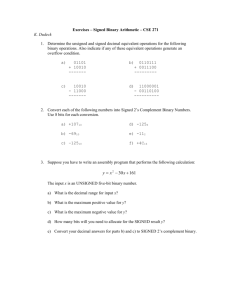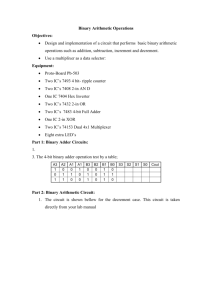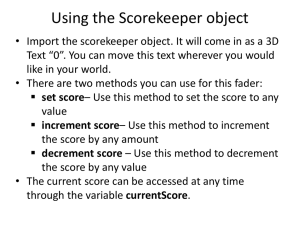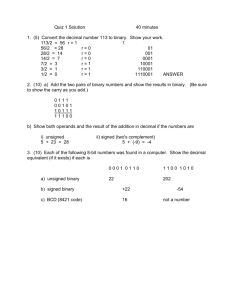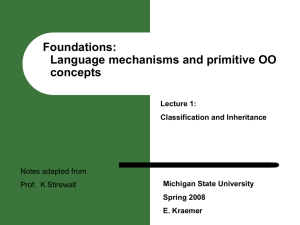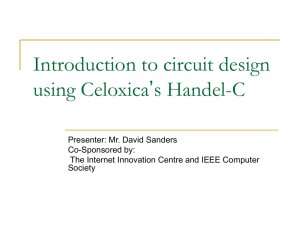final06
advertisement
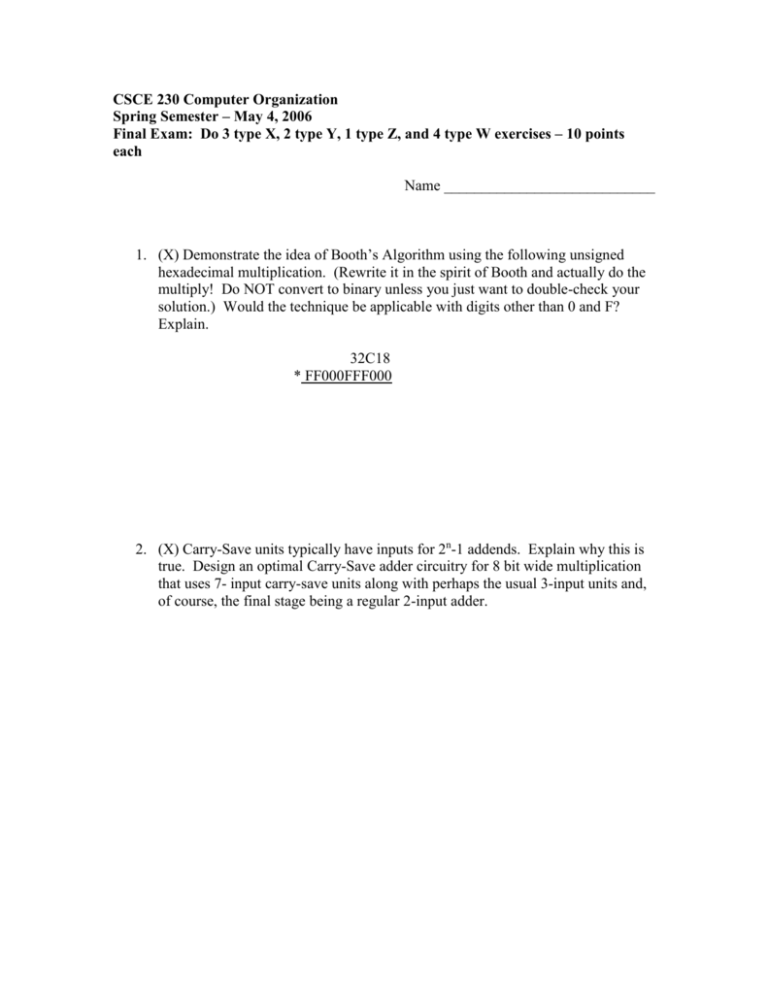
CSCE 230 Computer Organization Spring Semester – May 4, 2006 Final Exam: Do 3 type X, 2 type Y, 1 type Z, and 4 type W exercises – 10 points each Name ____________________________ 1. (X) Demonstrate the idea of Booth’s Algorithm using the following unsigned hexadecimal multiplication. (Rewrite it in the spirit of Booth and actually do the multiply! Do NOT convert to binary unless you just want to double-check your solution.) Would the technique be applicable with digits other than 0 and F? Explain. 32C18 * FF000FFF000 2. (X) Carry-Save units typically have inputs for 2n-1 addends. Explain why this is true. Design an optimal Carry-Save adder circuitry for 8 bit wide multiplication that uses 7- input carry-save units along with perhaps the usual 3-input units and, of course, the final stage being a regular 2-input adder. 3. (X) Perform the following operations, making certain that the result is properly rounded and normalized (just like the operands). Assume unsigned binary notation for everything but the exponent part! 1.101011 * 22 + 1.100101 * 2-1 1.001101 * 28 - 1.001011 * 28 1.100000 * 2-8 * 1.100000 * 28 4. (X) Complete the following table, showing the decimal values assuming the binary numbers are unsigned, 2’s comp, biased (also called excess), and hexadecimal. The first person to burst out in laughter for at least 15 seconds gets 2 bonus points. The bias should be 2n-1, where n is the number of digits in the binary string. Binary 0001 1111 1001 01101100 Unsigned 2’s Comp. Biased Hex 5. (X) Demonstrate non-restoring integer division by dividing 111,1111,1000 by 1010. Assume both these values are positive. 6. (Y) Consider a processor with 1024 general purpose registers. However, only a single 32 register block may be accessed at any given moment. A special “register block pointer” register holds the address of the beginning of the 32 register block. All instructions that access registers automatically use this special register. The jal instruction automatically adds 16 to this register and a new rtl (return from link) subtracts 16. An exception occurs if this register space memory is exceeded. Design this register block and associated pointer register, exception line, and special 16 adder/subtracter. Discuss how one might use this feature to make nested function calls. 7. (Y) Discuss the feasibility, usefulness, and practicality of making a) the program counter and b) the memory data register into a general purpose register. 8. (Y) Consider modified load and store word, and increment/decrement commands in which there is an additional 2 bit field that indicates the desired level of indirection. For the load/store, a 00 means the data in the address field is immediate (is sign extended and placed directly in the destination if instruction is load); a 01 means that this is a normal load or store; a 10 means that the real address to load/store can be found inside memory at the given address; and a 11 means yet another level of indirection. The first person to break out in uncontrollable sobbing gets 2 bonus points. For the increment/decrement commands, 00 indicates the index register (while memory is totally untouched); 01, 10, 11 operate similarly to the load/store). a. Sketch memory and registers and demonstrate how each of these options may work. b. Discuss and demonstrate how to use these new commands to access arrays. 9. (Z) Implement the modified indirect load or store word command (your choice!) on the multi-cycle machine from the text. 10. (Z) Implement the new increment or decrement command on the multi-cycle machine from the text. 11. (W) What might be the steps to send a single character to the printer (a) using polling? (b) Using interrupts? The first person to get up and exclaim loudly how much he/she enjoyed the class gets 2 bonus points. Assume there is a memory mapped data register and a status register that indicates ready and interrupt enable. 12. (W) Compare/contrast data transfer on synchronous and asynchronous busses. 13. (W) Discuss the concept of handshaking. What signals are needed? How does the timing work? 14. (W) How might an I/O operation be initiated, performed, and ended using DMA (eg. In figure 10.17 and 18) for writing a block of memory of some given size from some given location to disk at some given track and sector? The first person to stand up and accuse another of cheating gets 2 bonus points. The accused also gets 2 bonus points. Would the processor necessarily be blocked from accessing memory during the entire time of transfer? Explain. 15. (W) The UART in figure 10.25 does not show the address bus or control bus for the processor. Assume the UART is memory mapped starting at location 0. Draw the circuitry to decode the address(es) and store/read from the relevant register(s). hint: What registers need to be read? Written?

